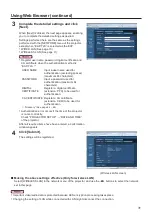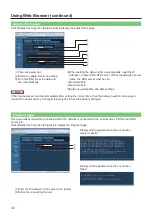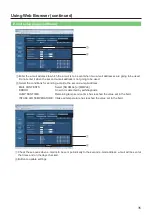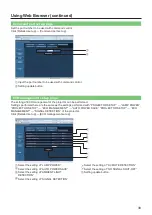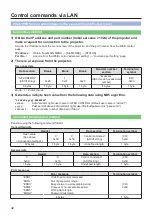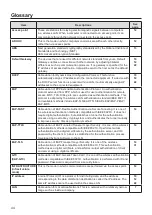
45
Glossary (continued)
Item
Descriptions
See
page
MAC address
Each network adapter has its own ID No.
A discrete ID No. is assigned to each and every network adapter around the
world. These IDs are used to exchange data between adapters. These IDs
are a combination of a discrete number managed and assigned by the IEEE to
each individual manufacturer and a unique number assigned to each individual
adapter by the manufacturer.
20
MD5
(EAP-MD5)
Abbreviation of EAP-Message digest algorithm 5. It is one of the wireless
authentication methods compatible with IEEE 802.1X. Authentication is
performed with ID and password. Password is sent encrypted with challenge &
response method.
14
MS-CHAPv2
(EAP-MS-CHAPv2)
Abbreviation of EAP-Microsoft Challenge Handshake Authentication Protocol
v2. It is one of the wireless authentication methods compatible with IEEE
802.1X.It performs mutual authentication using a one-way encrypted password.
14
Open System/
OPEN
This is an authentication of wireless signals employing a public key
encryptosystem.
13
PEAP
Abbreviation for EAP-Protected EAP. It is one of the wireless authentication
methods compatible with IEEE 802.1X. It performs mutual authentication with a
digital certificate by the authentication server, and ID/password by the client.
14
RADIUS server
RADIUS is an abbreviation of Remote Access Dial In User authentication
Service, and it is a protocol used for authentication in various networks such as
wireless LAN. An authentication server compatible with the protocol is called a
RADIUS server.
The RADIUS server eliminates the need of registering user information
separately in each device even when there are multiple network devices, and
enables integrated management of multiple network devices and users.
14
Shared Key/
SHARED
This is a secret key encryptosystem for wireless signals in which authentication
is performed with a key pre-set in the WEP.
Other terms for this method, in which the same key is used for both encryption
and decryption, are “shared key encryptosystem” and “common key
encryptosystem”.
13
SSID
Abbreviation for Service Set ID. The SSID identification code must be set to
distinguish equipment included in a wireless LAN that uses access points from
equipment not included in that LAN.
This may appear as the “ESSID” or the “network name” for wireless LAN
adapters made by some manufacturers.
12
22
Subnetmask
This limits the range of the IP addresses assigned to computers in order to
divide the network into a number of sections during TCP/IP connection. The
value used to divide the network at this time is called the subnetmask.
10
12
22
TKIP
Abbreviation for Temporal Key Integrity Protocol.
This encryption protocol provides even greater security than WEP because it
changes the encryption key at fixed intervals.
13
WEP
Abbreviation for Wired Equivalent Privacy. This is a method for encrypting
communication data. The encryption key is created and notified only to the
communicating user, so the communication data cannot be decrypted by a third
party.
13
WPA-EAP
WPA2-EAP
Standard for the encryption method for wireless LAN. This is an encryption
method for corporations, and encryption is performed using the external server.
13
WPA-PSK
WPA2-PSK
This is a standard covering encryption methods used in wireless LAN.
It provides greater security than WEP, and has functions such as a user
authentication function and also TKIP (encryption protocol) which automatically
changes the encryption key at fixed intervals.
And this authentication requires no authentication server.
13

